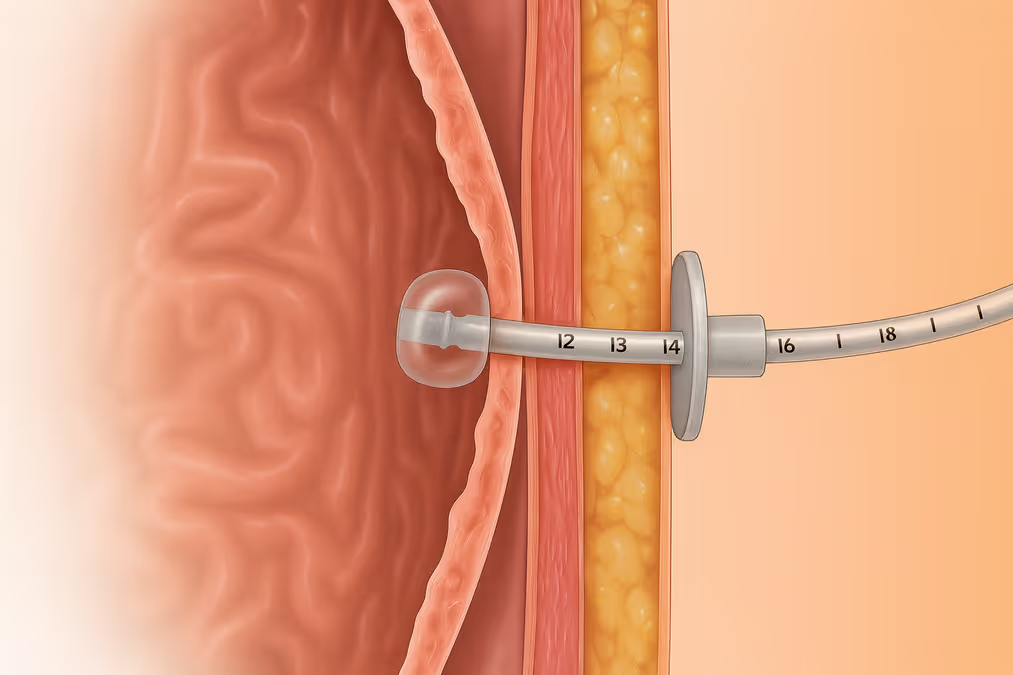Percutaneous gastrostomy - insertion of a gastric feeding tube (PEG) is a medical operation that allows the administration of nutrition directly to the stomach, in cases where the patient is unable to eat or swallow orally.
The procedure is carried out in an endoscopic approach, using advanced equipment, and provides a long-term solution for safe and effective feeding.
Procedure Description
PEG Feeding Tube Insertion
What is a PEG procedure?
The PEG (an acronym for Percutaneous Endoscopic Gastrostomy) is a procedure in which a feeding tube is inserted through the abdominal wall directly into the stomach, using an endoscope - a flexible, thin tube with a tiny camera at the end.
The procedure is considered safe, has a high success rate, and is most often performed under local anesthesia with a blur.
When is the insertion of a gastric feeding tube necessary?
The need for The PEG ARISES WHEN THERE IS SIGNIFICANT DIFFICULTY OR INABILITY TO SWALLOW OVER TIME, WHETHER AS A RESULT OF ILLNESS, INJURY OR CHRONIC MEDICAL CONDITION. Among the common situations:
- Neurological diseases (such as ALS, Parkinson's, stroke) that cause a swallowing disorder.
- Tumors or blockages in the esophagus or pharynx.
- Traumatic injuries to the head or neck.
- Medical conditions in which prolonged nutritional reinforcement is required.
Advantages of the procedure with an endoscopic approach
- Minimally invasive procedure - without the need for open surgery.
- Short execution time - usually between 20 - 30 minutes.
- Fast recovery - the patient can return to normal in a short time.
- Improving the quality of life - allows obtaining complete nutrition, fluids and medicines easily.
- Fewer complications in relation to traditional surgical methods.
Preparation for treatment
Preparation for examination of
PEG Feeding Tube Insertion
Preliminary examinations, fasting several hours before the operation.
Blur and local anesthesia - for comfort and safety.
Endoscopic examination - Insertion of the endoscope through the mouth into the stomach, to locate the point of entry.
Creating an opening in the abdominal wall - depending on the chosen location.
Pipeline insertion PEG - connecting it and ensuring its stability.
End of operation and instruction - Explanation to the patient and family members about use and maintenance.
Possible risks
As with any medical procedure, the insertion of a gastric feeding tube PEG May involve risks, although they are rare:
- Infection in the area of insertion
- Local bleeding
- Displacement of the pipe
- Response to Blur Drugs
The risk is reduced when the operation is performed by trained staff and in an experienced medical center.
After treatment
After the Examination of the
PEG Feeding Tube Insertion
Observance of daily hygiene of the pipe area.
Washing the hose after each use.
Periodic medical follow-up.
Replace the tube according to the doctor's recommendation (usually every few months).
Why choose us to perform The PEG?
Dr. Vosko and the clinic staff perform the insertion of a gastric feeding tube with endoscopic access with the help of advanced equipment, while ensuring safety, patient comfort, and minimal complications. We accompany the patient throughout the entire process - from diagnosis to follow-up after the procedure.
summary
PEG - The insertion of a gastric feeding tube is a life-saving operation in situations where normal feeding is not possible. Thanks to modern endoscopic technology, the procedure can be carried out safely, quickly and efficiently, while significantly improving the quality of life of the patient.
